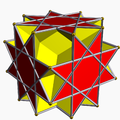Convex
There are 107,854,282,197,058 topologically distinct convex octadecahedra, excluding mirror images, having at least 11 vertices. [2] (Two polyhedra are "topologically distinct" if they have intrinsically different arrangements of faces and vertices, such that it is impossible to distort one into the other simply by changing the lengths of edges or the angles between edges or faces.)
Examples
The most familiar octadecahedra are the heptadecagonal pyramid, hexadecagonal prism, and the octagonal antiprism. The hexadecagonal prism and the octagonal antiprism are uniform polyhedra, with regular bases and square or equilateral triangular sides. Four more octadecahedra are also found among the Johnson solids: the square gyrobicupola, the square orthobicupola, the elongated square cupola (also known as the diminished rhombicuboctahedron), and the sphenomegacorona. Four Johnson solids have octadecahedral duals: the elongated triangular orthobicupola, the elongated triangular gyrobicupola, the gyroelongated triangular bicupola, and the triangular hebesphenorotunda. Among near-miss Johnson solids, the chamfered cube is one notable non-uniform octadecahedron.
In addition, some uniform star polyhedra are also octadecahedra:
This page is based on this
Wikipedia article Text is available under the
CC BY-SA 4.0 license; additional terms may apply.
Images, videos and audio are available under their respective licenses.
![Ball-and-stick model of the octadecahedral closo-undecaborate ion, [B11H11] , as found in the crystal structure of the benzyltriethylammonium salt. Closo-undecaborate(11)-dianion-from-xtal-3D-bs-17.png](http://upload.wikimedia.org/wikipedia/commons/thumb/a/ab/Closo-undecaborate%2811%29-dianion-from-xtal-3D-bs-17.png/250px-Closo-undecaborate%2811%29-dianion-from-xtal-3D-bs-17.png)











